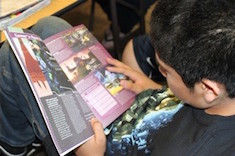There is a saying: “When eating an elephant take one bite at a time.” Attributed to Creighton Abrams, we have come to use this phrase to help us understand that any task, no matter how challenging, can be tackled bit by bit. The quote also reminds us that when we try to do too much at once, we run the risk of failure — or a serious case of lockjaw.
There may be nothing more intimidating to a student than the experience of sitting down and trying to read a text that is way too difficult. And while most researchers suggest that in this instance the reader should stop, drop, and find a text they can read independently, there are times (especially in middle/high school) where this is not an option. Whether it is a tough nonfiction text in Social Studies, a high-stakes test passage, or a challenging article on a beloved topic, we want our students to be empowered to try and read that which feels unreadable.
We want them to know how to eat the elephant of complex texts. Our job as teachers is to help students take a big idea and find the tiny details, the little steps, that can help make those big ideas a reality. With that in mind, here are a few bites we have taken when teaching students how to devour texts that are difficult for them.
How to Read a Complex Text (Narrative Text Edition)
Step 1: Acknowledge that if the text is truly complex and is being read independently, the comprehension will not be perfect.
We remember the instances well when our teachers seemed to be eternally unhappy with our answers about James Joyce. We didn’t “get it.” But we could probably get some of it. When teaching students to tackle tough text, we want to celebrate the inroads they make, not point out all the things they missed. In Kate’s upcoming book Falling in Love with Close Reading: Lessons for Analyzing Texts — and Life co-authored with Chris Lehman, Kate and Chris argue that only in a climate of encouragement, approximation, and ritual can any close reading work be effective.
Imagine you are asked to read the following on your own:
| You know in what reverence the royal white elephant of Siam is held by the people of that country. You know it is sacred to kings, only kings may possess it, and that it is, indeed, in a measure even superior to kings, since it receives not merely honor but worship. Very well; five years ago, when the troubles concerning the frontier line arose between Great Britain and Siam, it was presently manifest that Siam had been in the wrong. Therefore every reparation was quickly made, and the British representative stated that he was satisfied and the past should be forgotten. This greatly relieved the King of Siam, and partly as a token of gratitude, partly also, perhaps, to wipe out any little remaining vestige of unpleasantness which England might feel toward him, he wished to send the Queen a present — the sole sure way of propitiating an enemy, according to Oriental ideas. This present ought not only to be a royal one, but transcendently royal. Wherefore, what offering could be so meet as that of a white elephant? My position in the Indian civil service was such that I was deemed peculiarly worthy of the honor of conveying the present to her Majesty. A ship was fitted out for me and my servants and the officers and attendants of the elephant, and in due time I arrived in New York harbor and placed my royal charge in admirable quarters in Jersey City. It was necessary to remain awhile in order to recruit the animal’s health before resuming the voyage.
from The Stolen White Elephant by Mark Twain |
It is for most of us a bit tricky to “get” this text upon a first reading. Now imagine you are a kid. Clearly, expecting perfection is not going to work. Help is needed.
Step 2: Chunk the text.
One next step is to figure out exactly how big a bite we can take of the text. We encourage kids to draw a box or bracket around the part of the text they want to try to unlock. (Sticky notes work fine too.) Typically, no more than a paragraph or even a few lines is a good-sized bite. A helpful way to know when to chunk is to stop when your head is swimming and your thinking sounds like one big “Huh?”
Step 3: Read the chunk one time, asking, “What actually happens here? What is one thing a character does here?”
We have to start with the basics. Almost any kid with almost any text can read a small chunk and say one thing that happens. You could start a chart like this:
|
First Read |
Second Read |
Third Read |
In the first column, encourage students to name something they see happening. When tackling the text above, seventh graders have said things like:
- There’s an elephant.
- The King gave Britain an elephant.
- The guy is taking an elephant to Britain as a gift from Siam.
Here is where as their teachers we need faith that more will come, and that this is a great beginning. Each statement is true after all, and when we nod happily instead of shaking our heads “no,” our kids feel more confident.
Step 4: Read the chunk a second time, asking, “What emotion or trait do I see here?”
Good comprehension is being able to not only retell what happened, but say more about a text. One way to say more is to coach students to return to the chunk of text to reread, this time looking for character emotions or traits such as:
|
First Read |
Second Read |
Third Read |
| There’s an elephant.
The King gave Britain an elephant.
The guy is taking an elephant to Britain as a gift from Siam. |
They love elephants and worship them I think.
Siam did something wrong.
They were grateful? That’s why they gave the elephant as a gift. |
While comprehension at this point is not complete (What did Siam do wrong and why were they grateful? What does the narrator have to do with it?), it is functional. Even if students were to stop here, these multiple focused reads help students build confidence, discover the essential work of rereading, and build a pretty good sense of what a text is saying.
Step 5: Read the chunk of text a third time, asking, “What do I notice the author doing? What kind of language does s/he use?”
For this last read, ask students to notice anything they see the author doing. Encourage students to simply say “He is using big words,” or “Her sentences are really long,” and be thrilled when they notice descriptive language, symbolism, or allusions. This kind of reading gets students familiar with the text’s rhythm and flow, so that they become less intimidated as the text goes on.
Step 6: Rinse and Repeat.
Students now move onto the next chunk of text and repeat the process. Of course, if students are facing a long text and you suggest they read and take notes on each paragraph three times, your students may lose the will to live. Be sure to tell them that it gets easier as the text goes on, and that they will get better as they become familiar with the text and author’s style.
The payoff comes when students, stringing these multiple reads together, say loud and proud, “I think Mark Twain uses imagery here to show how much the people of Siam worship the elephant that they are giving to Britain.”
While there is no getting around the hard work of reading complex texts, there are ways to help students face the daunting task with confidence and success.
One bite at a time, we can get there.










